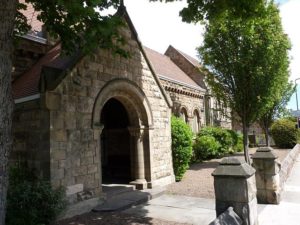With the arrival of the railway in 1850 and the development of North Berwick as a popular summer golfing retreat and health resort for people from all parts of Scotland and south of the border the number of Episcopalians in the town grew rapidly. Initially they worshipped in a large unfurnished room in Market Place known as the Burgh Schoolroom. When it was clear this was no longer adequate the main heritor of the town, Sir Hew Hamilton- Dalrymple, 6th Bart., gifted a piece of land to the west of the town for the building of a new church. A small Romanesque building, designed by the architect John Anderson was
erected.
St Baldred’s was consecrated on 23rd October 1862. The ceremony was performed by Samuel Wilberforce, Lord Bishop of Oxford who happened to have an engagement in Edinburgh and stood in for the Bishop of Edinburgh who was indisposed. It was one of several churches built at this time as a response to the revival of the Episcopal Church in Scotland. The Episcopal Church’s influence had been damaged by its association with the Jacobite cause of the previous century but its rehabilitation was completed with the 1864 Act of Parliament removing the last restrictions on Scottish clergy in Holy Orders.

St Baldred’s was cleverly extended over the 30 years following its consecration with the addition of many fine features in stone, wood and glass. The famous and beautiful Lorimer porch was added in 1918. It was designed by Sir Robert Lorimer and financed by the families of two young men, members of the congregation, who had lost their lives during the great War (1914-18). In 1919 a war memorial was erected in St Baldred’s to honour the members of the congregation who had died in that conflict.
During the latter half of the 20th century the north aisle was blocked off in order to provide much needed hall space. This has resulted in the unique situation of the preacher having to exit the church in order to gain entry to the pulpit!
The building was upgraded and refurbished in 2004. Pews were removed at the rear of the main chancel to make room for people to gather and circulate. The wall between the All Souls Chapel and the hall was also removed to increase the size of the hall and provide more space for congregational and other social events. The All Souls altar was moved to the rear of the main chancel facing the south door. Together with the installation of much improved cloakroom facilities and a fully equipped kitchen, the church has blossomed as a centre for social and outreach events and for community use as well as worship.
